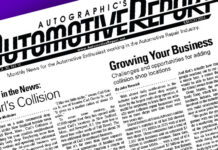ASSOCIATION LEADERS EXPLAIN WHY IT’S TIME FOR YOUR SHOP TO JOIN
By John Yoswick
Unlike many other professions, only a small percentage of collision repairers — often estimated at less than 10 percent — belong to a trade association. This can significantly hamper the ability of these associations to affect change and benefit the industry.
Yet despite their often scarce resources, many of these associations often can point to significant accomplishments and benefits they offer the industry.
So if you’re among the shops that haven’t ponied up the few hundred dollars it generally takes to belong to a trade association, perhaps it’s time to consider supporting the work these groups are doing on your behalf. There are generally significant benefits — tangible and intangible — for doing so.
We asked association leaders around the country to share what they see as just one or two of the benefits of association membership. Here’s what they had to say. The benefits available through an association in another state may not apply to yours, but what they have to say still offers an idea on what shops can enjoy by banding together.
Knowledge is power
Texas shop owner Burl Richards said the Auto Body Association of Texas (www.abat.us) was formed last year because collision repairers “needed a voice.”
“All the information that we receive from insurance companies is one-sided, in their favor,” Richards said. “In other words, ‘You’re the only one…’”
Richards said the association brings in speakers and presentations at its meetings to “to share information on what is going on in the industry, and to discuss new procedures, equipment, processes, etc.”
“We have learned so much over the last year, and knowledge is power,” Richards said.
He said the association intends to work on legislation to help the consumer, ensure safe repairs, and get shops paid for repair processes and procedures. That will enable shops to invest in the equipment needed to repair increasing sophisticated vehicles.
“The lawn mower repair shop down the road gets $15 an hour more than my labor rate,” Richards said. “Have you ever compared electrician, plumber or appliance-repair rates to a body shop? There’s work to be done, and an association is a way to unite shops and combine individual voices into one loud voice.”
You’re not ‘the only one’
Like Richards, Luz Rubio, executive director of the Automotive Service Association (ASA) of Arizona (www.asaaz.org), said one of the real values of association membership is knowing that you’re not “the only one.” She said her group coordinates meetings among shop owners to share “best practices” and discuss practical solutions to the challenges they all share.
She said that while getting legislation enacted is one role associations can serve, they can also help represent the industry’s interest in opposing some legislation. In 2011, for example, ASA of Arizona opposed a bill that would have limited a shop’s ability to charge for vehicle storage. She said that opposition helped stop the bill from getting a hearing.
“The bill would have forced shops, in many situations, to absorb the costs associated with vehicle storage or bill it to the vehicle owner,” Rubio said. “Shops need to understand that their ongoing membership allow the associations to continue. Without an association ‘watching out’ for their interest, issues like [this storage legislation] will be introduced without shops’ knowledge, and approved without a fight, which can have a very negative effect on the collision industry.”
Pick up the phone for help
Like many associations, the Alliance of Automotive Service Providers (AASP) of New Jersey (http://aaspnj.org) offers its members discounts on credit card processing, insurance, payroll and uniform services, etc. Discounts like these can often offset some or all the costs of membership dues.
But Charles Bryant, executive director of the association, points to two other member benefits that he thinks make association membership particularly valuable.
First, the association operated a “labor pool” to help match workers looking for employment with member shops looking for workers.
“Over the years, the AASP-N.J. labor pool has placed hundreds of workers in AASP-N.J. member shops,” Bryant said, noting that the service is free to members.
AASP-N.J. also offers a “hot line” that member shops can call when they need “quick answers to questions pertaining to the regulations that govern auto property damage claim settlements, and general questions pertaining to the industry.”
Bryant said he has much of the documentation related to laws and guidelines, and if a member calls with a question he can’t immediately answer, the member can “concentrate on running his or her business while the answer is being researched.”
“Many members have been able to make one phone call that resulted in solving a problem that the shop had been dealing with for months,” Bryant said.
Discounted training
Mike Sperry of the Indianhead Autobody Association, which represents shops in a 22-county region of Wisconsin, said his group’s meetings bring shops and suppliers together to share ideas that “ultimately make us all stronger.”
One unique benefit: The association will reimburse members for one-third the cost of I-CAR training, Sperry said.
Colleagues, not competitors
Shop owner Tony Ferraiolo said one of the main things he and other members of the Auto Body Association of Connecticut (www.abaconn.com) have come to realize is that they should view each other as colleagues rather than competitors. Working together through an association, he said, shops can “support legislative efforts to ensure the insurance industry abides by state laws and regulations,” and bring in the latest information from the auto manufacturers and other industry professionals.
Over more than a decade, the association and its members battled a class-action lawsuit against The Hartford on behalf of approximately 1,500 shops in the state. The Connecticut Supreme Court this year overturned the $34 million judgment the shops had won, but Ferraiolo said that only makes it all the more critical that shops “understand the control the insurance industry wants [over] autobody repair shops, and the consumer safety [issues] associated with repressing an industry.”
“It’s time to band together for the common goal of saving this industry,” Ferraiolo said.
Active on the legislative front
“The collision repair business grows more challenging each and every year, and if repairers are to continue to thrive and succeed, their support and active involvement in their local and national trade associations is more critical than ever before,” Judell Anderson, executive director of the Alliance of Automotive Service Providers of Minnesota (AASP-MN) (http://aaspmn.org) said.
Anderson said her association brings to its members the same type of “high-level” educational programs offered at national industry events without the time and expense of traveling out-of state.
The association is active on the legislative front as well.
“We have helped our members’ bottom lines by changing taxation on paint and materials,” she said. “We’ve passed legislation that prohibits insurers from unilaterally and arbitrarily disregarding a repair operation or cost identified by an estimating system.”
The association also just committed $50,000 to support a campaign designed to feed the pipeline of future employees, informing potential students and employees about the rewarding opportunities that exist within the automotive industry.
But those important benefits aside, Anderson said, it can just make good financial sense for a shop to belong.
“In 2015 alone, the association distributed more than $78,000 in rebates to members participating in AASP-MN’s uniform program, and more than $68,000 in dividends to members participating in our garagekeepers’ insurance program,” Anderson said.
Being part of the solution
Sue Peterson of the Wisconsin Auto Collision Technicians Association Ltd. (http://wactal.com) said members of her group save an average of $600 through the associaton’s business insurance program, more than covering their annual dues.
She said in addition to legislative representation, WACTAL interacts with regulatory and other state agencies on behalf of the industry; there’s some differences of opinion on how to interpret Wisconsin law related to replacement of vehicle information labels, for example, so the association is seeking clarification.
“There’s value in being part of a group where you can speak with others about what’s going on in the industry, how the industry is changing, and how to move forward through those changes,” Peterson said. “There’s value in being among others who share their struggles as well as their successes, and to collectively band together to be part of the solution instead of part of the problem.”
Giving shops a voice
Many state groups are affiliated with the national Society of Collision Repair Specialists (www.scrs.com), which gives those members access to the benefits SCRS offers its direct members as well.
SCRS Executive Director Aaron Schulenburg said when he asks new shop members why they’ve joined, they rarely point to a specific issue or member benefit.
“Business owners are looking for a voice that resonates with them, an organization they can be proud of, and one that tackles the issues that are important to them,” Schulenburg said. “It is common that our new members simply believe there isn’t a more dedicated or recognized advocate for collision repairers, and that the work we are doing and the programs we’ve developed speak to a mission that resonates with them. Our mission is quite simply to educate, inform and represent the collision repairer, and all our efforts revolve around those core objectives.”
Schulenburg pointed to a number of things SCRS brings to the industry. Along with the ASA and AASP, for example, SCRS supports the Database Enhancement Gateway (www.degweb.org), which allows anyone in the industry to submit concerns related to errors or omissions in the collision estimating databases. SCRS offers an industry news source (www.repairerdrivennews.com) and a free “Guide to Complete Repair Planning” (http://tinyurl.com/ntsco5g) to help shops improve their estimating. The association also offers training during the annual SEMA show.
Think local and national
Members of several state associations cited their affiliation with a national association as one of the key benefits of membership they offer. Shop owner John Mosely of the Mississippi Collision Repair Association (http://mscra.net) said he pays dues not just to the state group but to SCRS as well, believing it is a very worthwhile investment.
“No other association steps up and represents this industry with the dedication and perseverance expressed by the SCRS,” he said. “The people behind SCRS are the voice for the repair professionals who make up this industry.”
SCRS, he said for example, provides support for legislative efforts at both the state and national level.
“My local association, AASP-Massachusetts (http://aaspma.org), does a great job handling the issues we face here in our state, but being a member of SCRS bridges that gap between state and national for me,” agreed Adam Ioakim of Hogan & Van Auto Body in Medford, Mass. “The estimating tips [that SCRS distributes weekly] are a great reminder of areas that we can refocus on and make sure we are not letting any ‘not-included operations’ slip out our door. Their handout showing [how] ‘partial refinish’ just doesn’t add up helps me regularly articulate to insurance appraisers that we will not accept it.”
“Being a part of a national association like SCRS, and their state-level affiliate, the Montana Collision Repair Association (http://mtcollisionrepair.com/), has been vital to American Auto Body’s growing success,” Mariah Litton of the Billings, Mont., shop said. She said no matter what else an association offers, the biggest benefit is the interaction it allows you to have with other shops owners.
“I have had the opportunity to network with well-respected shops in not only Montana but throughout the country,” Litton said. “Simply knowing and interacting with fellow association members and others who attend the education programs, conferences and events puts a myriad of resources at my disposal for improvement and problem-solving. Whether it be calling a fellow association member to see how they are handling OSHA mandates, or working with legislation to create laws benefiting the industry and our customers, I have an amazing support system behind me.”
‘You’re not alone’
Clearly, association membership offers a wide range of benefits. But SCRS’ Schulenburg said one of the most important benefits is largely intangible.
“What most people want and need more than anything is a constant reminder that they are not alone,” Schulenburg said. “In an association, they have colleagues who are fighting the same fight, and they know that, collectively, the community they belong to is greater than the simple sum of its members.” •
John Yoswick, a freelance writer based in Portland, Ore., who has been writing about the automotive industry since 1988, is also the editor of the weekly CRASH Network (for a free 4-week trial subscription, visit www.CrashNetwork.com). He can be contacted by email at jyoswick@SpiritOne.com



